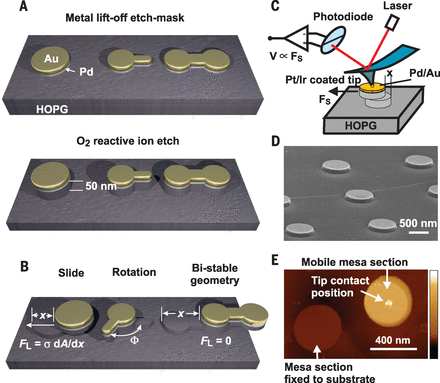Founder of TriboNet, Editor, PhD (Tribology), Tribology Scientist at ASML, The Netherlands. Expertise in lubrication, friction, wear and contact mechanics with emphasis on modeling. Creator of Tribology Simulator.
Experimental measurement of adhesion and friction in mesoscopic graphite contacts
Two-dimensional materials, such as graphite, expose an intriguing, but poorly understood low-friction behavior – superlubricity. Various aspects of superlubricity have been addressed by researchers, mostly based on theoretical considerations, however, accurate experimental measurements of adhesion and friction in 2D materials have not been performed until recently.
A team at IBM Research-Zurich has performed accurate direct measurements of the adhesion and friction forces in mesoscopic structures made of highly oriented pyrolytic graphite (HOPG). Two planes of HOPG were rubbed against each other and the forces were measured using Atomic Force Microscope (AFM). The team was able to measure the friction coefficient to be as low as ![]() , which is several orders of magnitude smaller than typical friction coefficient of
, which is several orders of magnitude smaller than typical friction coefficient of ![]() in dry sliding contacts. Besides, the researchers were also able to measure the interface energy to be
in dry sliding contacts. Besides, the researchers were also able to measure the interface energy to be ![]() , which is in excellent agreement with theoretical predictions (Kolmogorov et al. model, see the references in the original article).
, which is in excellent agreement with theoretical predictions (Kolmogorov et al. model, see the references in the original article).
The research may be helpful in designing MEMS devices, transistors and other nano-scale devices.
Credit for image: Adhesion and friction in mesoscopic graphite contacts, Science 8 May 2015: Vol. 348 no. 6235 pp. 679-683.
For further information: Adhesion and friction in mesoscopic graphite contacts, Science 8 May 2015: Vol. 348 no. 6235 pp. 679-683


Be the first to comment